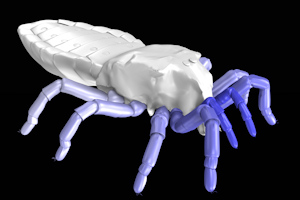Ancient arachnid 'brought back to life'
A stunning video based on fossils of a 410-million-year-old arachnid – one of the first predators on land – recreates the animal walking.

Researchers from ICAL and the Museum für Naturkunde, Berlin, used exceptionally preserved fossils from the Natural History Museum in London to create the video showing the most likely walking gait of the animal; the study is published in a special issue of the Journal of Paleontology.
The scientists used the fossils - thin slices of rock showing the animal’s cross-section - to work out the range of motion in the limbs of this ancient, extinct early relative of the spiders. From this, and comparisons to living arachnids, the researchers used an open source computer graphics program called Blender to create the video showing the animals walking.
“When it comes to early life on land, long before our ancestors came out of the sea, these early arachnids were top dog of the food chain,” said author Dr Russell Garwood. “They are now extinct, but from about 300 to 400 million years ago, seem to have been more widespread than spiders. Now we can use the tools of computer graphics to better understand and recreate how they might have moved – all from thin slivers of rock, showing the joints in their legs.”
Co-author Jason Dunlop, a curator at the Museum für Naturkunde, Berlin, said: “These fossils – from a rock called the Rhynie chert – are unusually well-preserved. During my PhD I could build up a pretty good idea of their appearance in life. This new study has gone further and shows us how they probably walked. For me, what’s really exciting here is that scientists themselves can make these animations now, without needing the technical wizardry – and immense costs – of a Jurassic Park-style film.
“When I started working on fossil arachnids we were happy if we could manage a sketch of what they used to look like; now we can view them running across our computer screens.”
This work is part of a special collection of papers on three-dimensional visualisation and analysis of fossils published in the Journal of Paleontology.
Dr Garwood added: “Using open-source software means that this is something anyone could do at home, while allowing us to understand these early land animals better than ever before.”
Ends
Notes for editors
The video of the 410-million-year-old arachnid walking is available to watch/download on the University of Manchester press office YouTube channel.
Journalists can obtain a copy of the paper, ‘The walking dead: blender as a tool for palaeontologists with a case study on extinct arachnids,’ by R. Garwood and J. Dunlop, published in the Journal of Paleontology, by contacting the press office. Academics and students can access it through their institutional log in: doi: 10.1666/13-088
Media enquiries to:
Aeron Haworth
Senior Media Relations Officer
Faculty of Engineering and Physical Sciences
The University of Manchester
Tel: 44 (0)161 275 8387
Mob: 44 (0)7717 881563
Email: aeron.haworth@manchester.ac.uk
ICAL author- Russell Garwood
External coverage
Although we make every effort to ensure these links are accurate, up to date and relevant, ICAL and The University of Manchester cannot take responsibility for pages maintained by external providers.


